Exercise : Solutions of Questions on Page Number : 170
Q1 : Draw in your notebook the symbols to represent the following components of electrical circuits: connecting wires, switch in the ‘OFF’ position, bulb, cell, switch in the ‘ON’ position, and battery.
Answer :
|
Component of electrical circuit |
Symbol |
|
Connecting wires |
|
|
Switch in the |
|
|
Bulb |
|
|
Cell |
|
|
Switch in the |
|
|
Battery |
|
Q2 : Draw the circuit diagram to represent the circuit shown infigure.
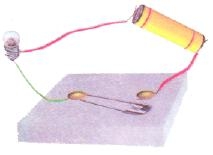
Answer :
In the given circuit, one terminal of the bulb is connected with one terminal of the cell while their other terminals are connected to a safety pin. However, the safety pin is not connected with one of the drawing pins. Thus, the circuit is not complete. Hence, safety pin represents a switch in ‘OFF’ position. The circuit diagram of the given figure is shown in the following figure.

Q 3: Figure shows four cells fixed on a board. Draw lines to indicate how you will connect their terminals with wires to make a battery of four cells.

Answer 3:
To make a battery, the negative terminal of one cell must be connected to the positive terminal of the next cell. The wire indicates the manner in which the given cells should be connected with each other, as shown in the following figure.

Q4 : The bulb in the circuit shown in Figure does not glow. Can you identify the problem? Make necessary changes in the circuit to make the bulb glow.
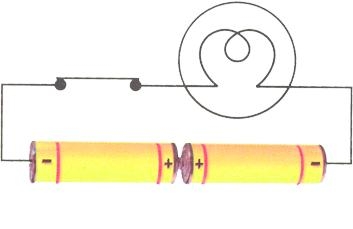
Answer :
The bulb in the circuit is not glowing because the two cells are not connected properly.
To make the bulb glow, the negative terminal of one cell should be connected to the positive terminal of the other cell, as shown in the given figure.
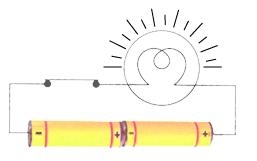
Q5 : Name any two effects of electric current.
Answer :
The two effects of electric current are
(i) Heating effect of electric current
(ii) Magnetic effect of electric current
Exercise : Solutions of Questions on Page Number : 171
Q6 : When the current is switched on through a wire, a compass needle kept nearby gets deflected from its north-south position. Explain.
Answer :
When a current is switched on through a wire, the wire starts behaving as a magnet. Hence, when a compass needle is placed near the given current carrying wire, it gets influenced by the magnetic effect of electric current and gets deflected from its North-South position.
Q7 : Will the compass needle show deflection when the switch in the circuit shown by figure is closed?
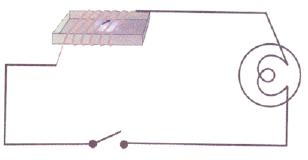
Answer :
No.
The given circuit does not have any current source. In the absence of current, the wire does not behave as a magnet and hence, the compass needle will not show any deflection.
Q8 : Fill in the blanks:
(a) Longer line in the symbol for cell representsits_________terminal.
(b) The combination of two or more cells is called a _________.
(c) When current is switched ‘on’ in a room heater, it __________.
(d) The safety device based on the heating effect of electric current is called a _________.
Answer :
(a) Longer line in the symbol for cell representsits__positive__terminal.
![]()
(b) The combination of two or more cells is called a __battery__.
To make a battery, the negative terminal of one cell is connected to the positive terminal of the next cell and so on.
(c) When current is switched ‘on’ in a room heater, it __produces heat__.
Working of a room heater is based on the phenomenon of heating effect of electric current.
(d) The safety device based on the heating effect of electric current is called a __fuse__.
Fuse is a safety device, which limits current in circuit and breaks the circuit if the current exceeds its maximum limit.
Q9 : Mark ‘T’ if the statement is true and ‘F’ if it is false:
(a) To make a battery of two cells, the negative terminal of one cell is connected to the negative terminal of the other cell. (T/F)
(b) When the electric current through the fuse exceeds a certain limit, the fuse wire melts and breaks. (T/F)
(c) An electromagnet does not attract a piece of iron. (T/F)
(d) An electric bell has an electromagnet. (T/F)
Answer :
(a) False
To make a battery of two cells, the negative terminal of one cell must be connected to the positive terminal of the other cell.
(b) True
The wire of the fuse is made of special material which has a low melting point. When large current passes through a fuse, it melts quickly and breaks the circuit.
(c) False
Working of an electromagnet is based on the magnetic effect of electric current. An electromagnet behaves as a magnet when current passes through it. Hence, it will attract a piece of iron.
(d) True
An electric bell has a piece of iron wound by a coil. When current passes through this coil, it behaves as an electromagnet.
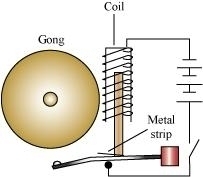
Q10 : Do you think an electromagnet can be used for separating plastic bags from a garbage heap? Explain.
Answer :
No.
Electromagnets can only attract magnetic materials. Plastic bag is a non-magnetic material and will not be attracted by an electromagnet. Hence, an electromagnet cannot be used for separating plastic bags from a garbage heap.
Q11 : An electrician is carrying out some repairs in your house. He wants to replace a fuse by a piece of wire. Would you agree? Give reasons for your response.
Answer :
No.
The electrician cannot be allowed to replace the fuse in the house by a piece of wire. This is because every wire cannot be used as a fuse filament. A fuse filament must have a low melting point such that it could melt and break in response of large amount of current. Most of the wires have high melting points.
Q12 : Zubeda made an electric circuit using a cell holder shown in Fig. 14.4, a switch and a bulb. When she put the switch in the ‘ON’ position, the bulb did not glow. Help Zubeda in identifying the possible defects in the circuit.
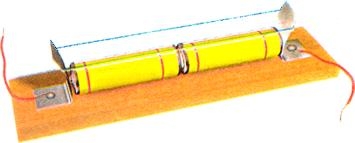
Answer :
One of the reasons may be that the rubber band used in the cell holder may not be tight enough to keep the two cells in contact with each other. If the cells are not in proper contact with each other, then the circuit will not be complete and current will not flow through the circuit. Hence, the bulb will not glow.
The other reason may be that the two cells are not connected properly. The negative terminal of one cell must be connected to the positive terminal of the other cell.
Exercise : Solutions of Questions on Page Number : 172
Q13 : In the circuit shown in figure
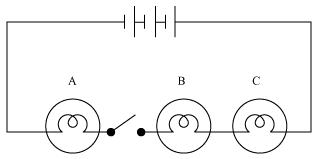
(i) Would any of the bulbs glow when the switch is in the ‘OFF’ position?
(ii) What will be the order in which the bulbs A, B and C will glow when the switch is moved to the ‘ON’ position?
Answer :
(i) No.
When the switch is in ‘OFF’ position, the current does not flow through the circuit. Hence, none of the bulbs will glow.
(ii) Bulbs will glow simultaneously.
When the switch is moved to the ‘ON’ position, then all the bulbs will glow at once. This is because they all are connected to the same battery and switch.